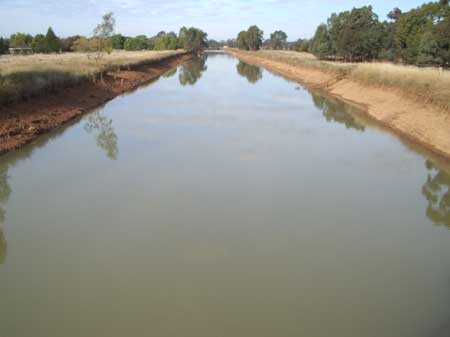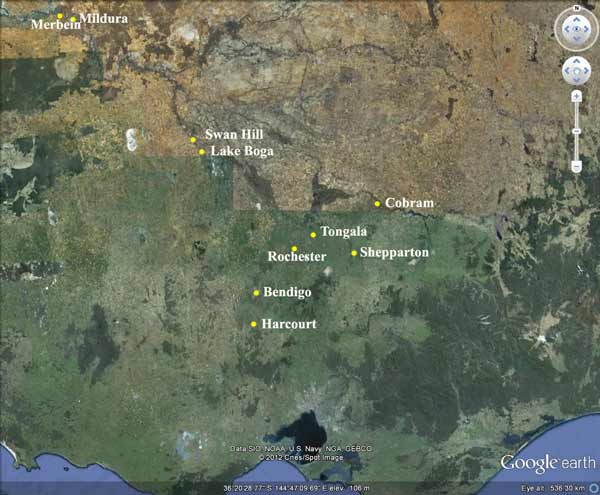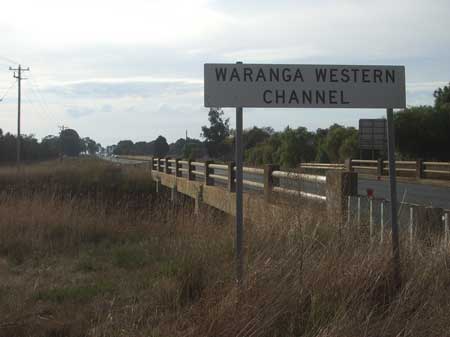EXPOSING DEVELOPERS WHO FAIL TO APPRECIATE AND RESPECT COMMUNITY, ENVIRONMENT AND SPIRIT OF THE LAND
Goulburn Murray Water
Herbicide Overkill in the Murray River Catchment
A long history of pesticide use in drains, channels and waterways.
The latest Controversy (Imazapyr)
September 8 2015: Spray Residues Linger
September 1 2015: Authority Cops Spray Over Timing
G-MW is still trying to clear irrigation channels that contain residue from the spray, two weeks after the irrigation season was supposed to have started. The authority says the spray containing Imazapyr was applied in May, June and July. Some landholders have been supplied with trucked-in supplies of stock and domestic water while they wait for the residue to disappear. Naring farmer Barry Croke said he saw G-MW spraying weeds in channels near his property in late July.
August 27 2015: Irrigators Miss Start to Season From Contamination in Channels
HUNDREDS of northern Victorian farmers have missed the official start of the watering season after their channels were contaminated with chemicals. Residual traces of herbicide were found in 370km of channels in the Murray Valley, Shepparton, Central Goulburn and Rochester irrigation areas. About 400 Goulburn Murray Water customers hope to be able to use the water for irrigation, stock and even domestic use by the end of this week. GMW spokesman Daniel Irwin said the water corporation applied a herbicide to selected channels during winter with the active ingredient Imazapyr to treat the aquatic weed arrowhead.
August 14 2015: Access to Channel Water to be Delayed
Weedicides Used By State Rivers & Water Supply Commission November 1972
| Acrolein | 94% Acrolein | Submerged weeds while covered in water. |
| Amitron 76 | 66% Dalapon & 11% Amitrole | Mixed species on banks of channels and drains |
| Ammonium Sulphanate | 95% Ammonium Sulphanate (known as Ammate X or AMS) | Controls sprouting of willows/poplars |
| Copper Sulphate | known as Bluestone | Algae control |
| Dalapon | 22-DPA Available as 85% active product Basfapon, Agripon, Propon Plus, Nupon, Dowpron etc | Cumbungi, canegrass, paspalum |
| Diuron | Diuron BL etc | Couchgrass in drains |
| Erase | Pellets 40% boron trioxide, 3.7% dalapon, 2% 2,4-D, 1% Atrazine | Small areas of weeds on channel banks and around structures |
| TCA | 79-90% trichloroacetic acid | Cumbungi, canegrass, ribbonweed, pond weed in drained channels |
| Tordon 50D | 5% picloram, 20% 2,4-D | Killing trees by bores drilled into trunks |
| Weedazol TL Plus | 25% Amitrole, 22% ammonium | Water couchgrass, cumbungi etc |
| Weedone LV57 | 36% 2,4-D | Cattail, common milfoil, jointed rush & spike rush in channels, arrowhead in streams |
| Weedone Special | 36% 2,4-D | Blackberry and furze. |
| Xylaquat | 85% Xylene with emulsifer | Submerged weeds in drains |
2,4-D
Amitrole
Diuron (Karmex and Monuron (Telvar) For Control of Water Couch Grass (1960's)
Use of Phenoxy Herbicides State Rivers and Water Supply System (1978)
Xylaquat Channel/Drain Herbicide Contaminated with Dioxins Controversy 1985
Victorian Communities drinking Channel Water (and water from Broken Creek) supplied by Goulburn Murray Water
Anecdotal Information Regarding Channel Spraying
Native Fish Facing Extinction! People facing drinking water quality problems.
Did you know that according to the EPA Victoria's 2006 Environmental Audit of the Goulburn River - Lake Eildon to The Murray River the mean annual concentration for Amitrole T in the Central Goulburn and Shepparton Irrigation Areas is estimated to be above the Australian Drinking Water Guidelines by over 250%. As a result of the EPA audit, Goulburn Murray Water had to test for Glyphosate, Amitrole, 2,4-D and AMPA over a 3 year period. (Guideline Heath limits for Amitrole are 10ppb, Glyphosate 1000ppb and 2,4-D 30ppb)
On 12/4/06 Glyphosate readings of 10,500ppb were detected in Drain 8, Ardmona, Midland Highway (AMPA was also detected on this day at 830ppb). On 10/4/06 Glyphosate readings of 940ppb were detected in the Community Surface Drain, Rodney Drainage System, Amitrole was detected at 1060ppb at the same location.
Amitrole was consistently detected for 5 weeks between 30/3/06 to 6/5/06 in Rodney Main Drain with the level peaking on 30/4/06 at 29ppb
In May 2006 readings for 2,4-D amine in Murray Channel CH1/5 reached; 2960ppb (9/5/06), 1920ppb(10/5/06), 1950ppb(11/5/06) & 2110ppb (12/5/06).
Residue testing in response to Goulburn River Audit 2005. Date 1/10/06
Did you know that over 60 communities rely on drinking water from irrigation channels in Victoria? How often are these channels sprayed and tested? Did you know that according to the reputable Pesticide Action Network, Amitrole is a carcinogen, a potential groundwater contaminant and suspected endocrine disruptor? Drinking water authority Goulburn Valley Water does not test for either Acrolein or Amitrole!
These herbicides, along with Acrolein are used by Goulburn Murray Water to control aquatic weeds growing in channels and irrigation drains. Acrolein is injected directly into flowing water, whilst Amitrole, Glyphosate and 2,4-D are spot sprayed when the weeds are not submerged. The Federal Regulatory body, the APVMA, has granted GMW permits to spray amitrole at 10L/ha and Glyphosate between 20 and 40 L/ha.
Channel water can be diverted to supply raw water for potable use.
GMW also uses a concoction of other herbicides to kill weeds growing along drains and channels. These herbicides most likely include Simazine, Sulfometuron and Metsulfuron Methyl. There must be a high possibility of these herbicides also entering channel water.
GMW also have permission to spray Glyphosate into the Broken Creek and Nine Mile Creek. Up until 1995 G-MW also used sodium 2,2 dicchloropropionate (2,2-DPA)!
2,4-D
Irrigation Services Division. SRWSC 2,4-D Residues in Stream Samples
2,4-D is used to control Arrowhead where traditionally it has been used in Broken Creek and some used in nearby channels and drains.
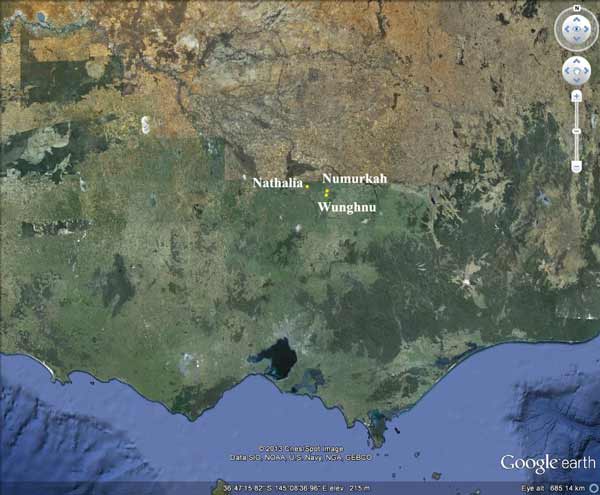
Waters From Nathalia (Broken Creek) 2,4-D residues (1971)
|
7/6/71
|
0.01ug/L
|
|
8/6/71
|
0.09ug/L
|
|
9/6/71
|
0.13ug/L
|
|
10/6/71
|
0.12ug/L
|
|
13/6/71
|
0.21ug/L
|
|
14/6/71
|
0.37ug/L
|
|
15/6/71
|
0.55ug/L
|
|
16/6/71
|
1.13ug/L
|
|
17/6/71
|
0.79ug/L
|
|
18/6/71
|
0.67ug/L
|
|
19/6/71
|
0.82ug/L
|
|
20/6/71
|
1.46ug/L
|
|
9/12/71
|
0.1ug/L
|
|
11//12/71
|
0.1ug/L
|
|
12/12/71
|
0.2ug/L
|
|
13/12/71
|
0.2ug/L
|
|
14/12/71
|
0.2ug/L
|
|
15/12/71
|
0.5ug/L
|
|
16/12/71
|
0.4ug/L
|
|
17/12/71
|
0.5ug/L
|
|
18/12/71
|
0.5ug/L
|
|
19/12/71
|
0.4ug/L
|
Amitrole
State Rivers and Water Supply Commission
Approval was given on 24th September 1962 at the Intergovernmental Committee on Pesticides for the State Rivers And Water Supply Commission to use Amitrole provided that the level in domestic drinking water did not exceed 0.3 parts per million. Gippsland was excluded from this approval as it is a goitre area. In June 1963 the Commission then adopted a maximum concentration of amitrole in streams of 0.002ppm.Amitrole Quantity Used 1963-1972
|
Year
|
Weedazol TL
|
Other Products
|
Total Amitrole
|
|
1963/4
|
952
|
144
|
1096
|
|
1964/5
|
1200
|
63
|
1263
|
|
1965/6
|
1517
|
366
|
1883
|
|
1966/7
|
1428
|
235
|
1663
|
|
1967/8
|
1557
|
173
|
1730
|
|
1968/9
|
1871
|
155
|
2026
|
|
1969/70
|
1779
|
272
|
2051
|
|
1970/1
|
1970
|
228
|
2198
|
|
1971/2
|
1940
|
268
|
2208
|
Amitrole was also used on cumbungi. Rate of application - 9 gallons of product per acre and the treatment period is usually December to March
Also note these figures including the highest pesticide residue detetected in Victoria, a whopping 0.43 parts per million in 1972 - 478 times over the current Australian Drinking Water Guideline for Amitrole. Source: Report On Amitrole in Waters State Rivers and Water Supply Commission 197(3?) [Submission to NHMRC on limit of Amitrole in Water].
In July 1983, the manufacturer of Amitrole, ICI withdrew Amitrole from sale. The replacement to Amitrole for the control of couchgrass in drains was Glyphosate.
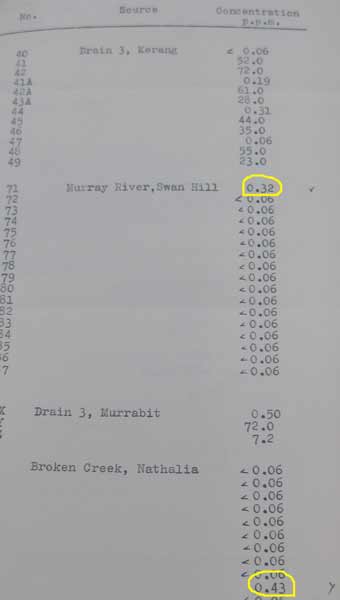
1972 Nathalia - Report on Amitrole in River Waters August 23 1972 - Amitrole 430ug/L (477.8xadwgh)
6/1/75 [report date] Broken Creek [Nathalia, Numurkah, Wunghnu Determination of Amitrole in Water Samples - State Rivers & Water Supply Commission - Amitrole 7.3ug/L (8.111 x adwgh)
6/1/75 [report date] Broken Creek [Nathalia, Numurkah, Wunghnu Determination of Amitrole in Water Samples - State Rivers & Water Supply Commission - Amitrole 6.3ug/L (7 x adwgh)
6/1/75 [report date] Broken Creek [Nathalia, Numurkah, Wunghnu Determination of Amitrole in Water Samples - State Rivers & Water Supply Commission - Amitrole 5.5ug/L (6.111 x adwgh)
13/12/73 Broken Creek [Nathalia, Numurkah, Wunghnu Determination of Amitrole in Water Samples - State Rivers & Water Supply Commission - Amitrole 3.7ug/L (4.111 x adwgh)
6/1/75 [report date] Broken Creek [Nathalia, Numurkah, Wunghnu Determination of Amitrole in Water Samples - State Rivers & Water Supply Commission - Amitrole 3.7ug/L (4.111 x adwgh)
6/1/75 [report date] Broken Creek [Nathalia, Numurkah, Wunghnu Determination of Amitrole in Water Samples - State Rivers & Water Supply Commission - Amitrole 3.7ug/L (4.111 x adwgh)
29/11/73 Broken Creek [Nathalia, Numurkah, Wunghnu Determination of Amitrole in Water Samples - State Rivers & Water Supply Commission - Amitrole 2ug/L (2.222 x adwgh)
20/12/73 Broken Creek [Nathalia, Numurkah, Wunghnu Determination of Amitrole in Water Samples - State Rivers & Water Supply Commission - Amitrole 2ug/L (2.222 x adwgh)
7. 22/6/06 Goulburn Valley Water Broken Creek Numurkah 2,4-D 17ug/l (56.67% 2011 adwg)14. 21/12/05 Goulburn Valley Water Broken Creek Numurkah Pentachlorophenol 1ug/L (10% 2011 adwg)
1980? Waters of Broken Creek State Rivers and Water Supply Commission [Nathalia/Numurkah/Wungnu?] Dieldrin 0.16ug/L (3.333% adwgh)
Xylaquat Channel/Drain Herbicide Contaminated with Dioxins Controversy 1981-85 - Things Go Better With Shell?
Regions impacted by the Xylaquat contamination issue 1981-5. Were any communities near these sprayed drinking the water?
Xylaquat was used for many years by the Rural Water Commission, however during 1981-5 it was used when the Xylaquat was contaminated with Dioxins. Xylaquat use in the Commission's Eagle Channel at Harcourt, led to a fish kill at the nearby Ottwood Park Trout Farm in January 1985. An investigation led to the conclusion that the Xylaquat was contaminated.
21/5/85: Report on Analysis of Contents of Xylaquat Containers mg/kg
| Aldrin | Dieldrin | ppDDE | ppTDE | ppDDT | o,pDDT | Total DDT | |
| Numurkah | 85 | 4 | 1 | 1 | 26 | 5 | 33 |
| Shepparton | 13 | 3 | 5 | 4 | 107 | 24 | 140 |
| Shepparton, Kyabram, Tongala, Numurkah | 75 | 5 |
Water Pesticide Levels ug/L at different sites in Harcourt Channel
|
Aldrin
|
DDE
|
TDE
|
DDT
|
Total DD's
|
Dieldrin
|
|
|
1.
|
0.05
|
0.03
|
ND
|
ND
|
0.03
|
0.62
|
|
2.
|
ND
|
0.03
|
0.01
|
0.02
|
0.06
|
0.07
|
|
3.
|
0.04
|
0.04
|
0.03
|
0.03
|
0.10
|
0.34
|
|
4.
|
0.01
|
0.06
|
0.03
|
0.07
|
0.16
|
0.10
|
|
5.
|
0.01
|
0.04
|
0.02
|
0.05
|
0.11
|
0.16
|
Sediment Pesticide Levels mg/kg
| Aldrin | DDE | TDE | DDT | Dieldrin | |
|
1.
|
0.08 | 0.03 | 0.02 | 0.02 | 0.11 |
|
2.
|
0.34 | 0.09 | 0.2 | 0.24 | 0.28 |
|
3.
|
0.09 | 0.23 | 0.06 | 0.11 | 0.11 |
|
4.
|
0.34 | 1.1 | 0.24 | 0.67 | 0.28 |
|
5.
|
0.32 | 0.77 | 0.30 | 0.07 | 0.5 |
Diuron (Karmex and Monuron (Telvar) For Control of Water Couch Grass (1960's)
Also used throughout the seventies.
Use of Phenoxy Herbicides State Rivers and Water Supply System (1978)
|
|
|
|
Annual Usage (litres)
|
Max Weekly Usage
|
|
Situation and Potential Water Contamination
|
|
1.
|
Mornington Peninsula
|
2,4,5-T
|
500-2000
|
100
|
Blackberry
|
Catchment areas of reservoirs, well away from
the high water mark. Low Potential
|
|
2.
|
Coliban System
|
2,4,5-T
|
100-200
|
20
|
Blackberry
|
Channel and drain reserves. Low Potential
|
|
3.
|
Coliban System
|
2,4-D
|
200-400
|
20
|
Furze
|
Channel and drain reserves. Low Potential
|
|
4.
|
Coliban System
|
Rushes
|
In Channels and drains. High Potential
|
|||
|
5.
|
Koo Wee Rup
|
2,4,5-T
|
50-200
|
50
|
Blackberry
|
Drain Reserves. Medium potential but drains
flow directly to sea.
|
|
6.
|
Koo Wee Rup
|
2,4-D
|
50-200
|
50
|
Woody spp.
|
Drain Reserves. Medium potential but drains
flow directly to sea.
|
|
7.
|
Shepparton
|
2,4-D
|
400-700
|
100
|
Arrowhead
|
Channels, drains, streams. High Potential.
|
|
8.
|
Murray Valley
|
2,4-D
|
50-200
|
20
|
Arrowhead
|
Channels, drains, streams. High Potential.
|
Aquatic Weed Management Commitee Residue Limits For Herbicides (1979?)
A. Limits adopted by the State Rivers and Water Supply Commission with the approval of the Pesticides Review Committee
| Acrolein | 0.1ppm at the point of discharge to the stream |
| Amitrole | 0.002ppm for irrigation water |
| 0.3ppm for potable water (zero in Gippsland) | |
| 2,4-D | 0.01ppm (arrowhead treatment) |
| 2,2-DPA | 0.004ppm where several irrigations with contaminated water |
| 0.004ppm where a particular pasture is irrigated once a year with contaminated water | |
| Diuron | 0.002ppm |
B. Limits for potable water (recently adopted by the NHMRC)
| Amitrole | 0.01ppm |
| 2,4-D | 0.1ppm |
| Diquat | 0.05ppm |
| Endothal | 0.6ppm |
| Glyphosate | 0.5ppm |
| Paraquat | 0.01ppm |
| Picloram | 1ppm |
| 2,4,5-T | 0.02ppm |
Victorian Communities drinking Channel Water (and water from Broken Creek) supplied by Goulburn Murray Water.
Anecdotal Information Regarding Channel Spraying
"In hindsight, we had not picked an ideal time to enter farming. In 1974, January, normally a droughty month, gave forewarning of what was to come with 132mm of rain. When rivers overflowed their banks, the locals surrounded their towns with sandbags in a desperate attempt to stem the rising waters. Our farm was hard hit: not by a river, but by the drainage channel which passed through a siphon at our boundary before tunnelling under the main irrigation channel. A large pipe that had been installed the previous year, at the insistence of the former owner, still could not handle a freak 529mm of rain during the cropping season, and the channel backed up to flood nearby farms.
The water authorities targeted our drainage channel for special attention. They sprayed it with herbicides so that weeds would not impede the water flow. They blitzed the channel until its banks were sterile, denuded and crumbling, and dead fish floated belly up, shining like a silver-scaled carpet and clogging the siphon. I remember the jeeps trailing huge herbicide vats, spraying along the easement by our house, and how more than once I packed Guy and John into the car and went away to escape the sickening smell. Our bore had been sunk beside that drainage channel. We usually collected rainwater from our roof for drinking, but pumped from the bore when the tank ran low.
Another time, a herbicide was added directly to the water and allowed to wash downstream. Our neighbour, Lionel, was told by one of the government workers that they had to drop the chemical in the channel from a bridge on the main road, because it was too explosive to carry across country. And then Lionel collapsed when the fumes wafted up from the channel near where he was working. In later years, when we were discussing events with Lionel, we came to suspect that this particular herbicide was acrolein - because the warnings we received to remove stock from the channel, and our indirect discovery of the chemical's explosive nature and its extreme volatility, all match what we now know to be the properties of acrolein.
We used no chemicals in our own cropping routine, but simply relied on the traditional cycle of fallow and rotation to conserve moisture and destroy weeds. Most irrigation farmers did not even use herbicides in those days. They slashed the weeds in their drains, so much so that tractor-drawn drain cleaners were one of Bernie's standard engineering lines. Now, everyone clears drains the quick-and-easy way, with herbicides. Mechanical drain cleaners are as obsolete as horse-drawn machinery.
The face of the tomato industry has changed even more rapidly. Sadly, the era of the small tomato grower has passed. Instead of signing with growers for five acres here and ten acres there, the canning factories now contract to farmers who plant hundreds of acres. Where our growers planted, hoed, and picked by hand, machines now plant and harvest, and herbicides control the weeds. Both methods, however, relied heavily on chemical pest control.
I remember how the spray plane would work down the paddock beside our house, zoom in low, spray a strip, lift, turn, and spray the next strip until the pilot covered the entire crop. Often he would turn above us, with his spray jets still operating, blasting our house and vegetable garden - even the babies' nappies drying on the clothes line. We may have been unafraid of these routine spray-runs (hopelessly naive I would call it now), but we certainly had no desire to drink the stuff. I can remember Bernie perched on the roof, disconnecting the spouting, and scrubbing the spray off before the next rain washed it into our tanks.
We will probably never know what concoctions blitzed our channels - our every attempt to find out has been fobbed off - but we do know that DDT and mevinphos were sprayed on and around our house. Even then, DDT had been banned across North America whereas here in Australia its toxicity was recognised only by a thirty-day withholding period between spraying and picking. So we did feel uneasy seeing bins of tomatos stacked at our gate the day after the crop had been sprayed. Although DDT was the first line of defence in the grub war, pests were already developing resistance to it: Bernie can remember one of our growers re-calling the plane for a double-strength blast when the bugs survived the first dose. When that, too, was ineffective, they tried mevinphos.
Mevinphos was then nothing more than a name to us. Now we know it as a neurotoxic organophosphate, one of the most deadly pesticides ever concocted." Source: Scribe Chemical Crisis - One Woman's Story - Humanity's Future. Diana Crumpler 1994
|
Colbinabbin
|
Waranga Western Channel
|
|
Corop
|
Waranga Western Channel
|
|
Dingee
|
Pyramid No1 Channel
|
|
Dookie
|
East Goulburn Main Channel
|
|
Girgarra
|
CG 7/12/9 Channel
|
|
Goorambat
|
Bore/Broken Creek
|
|
Katamite
|
RWC Channel
|
|
Katandra West
|
Shep 3/25 Channel
|
|
Kyabram
|
CG 23/9 Channel
|
|
Lockington
|
Campaspe No 24 Channel
|
|
Marcorna
|
Channel
|
|
Merrigum
|
CG23/9 Channel via pipeline from Kyabram
|
|
Mitiamo
|
Channel
|
|
Mysia
|
Waranga Western Channel
|
|
Nathalia
|
Broken Creek
|
|
Numurkah
|
Broken Creek
|
|
Picola
|
R.W.C. Channel
|
|
Pyramid Hill
|
Channel
|
|
Rochester
|
Waranga Western Channel/Campaspe No.2 Channel
|
|
St. James
|
Broken Creek
|
|
Stanhope
|
CG1/12/9 Channel
|
|
Tallygaroopna
|
R.W.C. Channel
|
|
Tatura
|
CG 3/5A Channel
|
|
Tongala
|
CG 19/28/9 Channel
|
|
Wunghnu
|
Broken Creek
|
Victorian Communites drinking Channel Water supplied by Wimmera Mallee Water (pre 2010).
According to Wimmera Mallee Water's website; 63% of their customers are supplied by the Wimmera Mallee Channel System. "the length of channel treated with chemical weedicides is growing as this form of treatment can defer the more expensive channel ditching in some instances. It is used extensively in the irrigation areas around Horsham where access along channels is a problem and introduced weeds such as Elodea are rapidly spreading... Generally, GMW is responsible for channel waterway areas and the neighbouring landholder manages weed control on channel banks and adjacent land".
|
Antwerp
|
Wimmera Mallee Channel System
|
|
Berriwillock
|
Wimmera Mallee Channel System
|
|
Beulah
|
Wimmera Mallee Channel System
|
|
Birchip
|
Wimmera Mallee Channel System
|
|
Brim
|
Wimmera Mallee Channel System
|
|
Charlton
|
Wimmera Mallee Channel System
|
|
Clear Lake
|
Wimmera Mallee Channel System
|
|
Culgoa
|
Wimmera Mallee Channel System
|
|
Dimboola
|
Wimmera Mallee Channel System
|
|
Donald
|
Wimmera Mallee Channel System
|
|
Dooen
|
Wimmera Mallee Channel System
|
|
Glenorchy
|
Wimmera Mallee Channel System
|
|
Great Western
|
Wimmera Mallee Channel System
|
|
Hopetoun
|
Wimmera Mallee Channel System
|
|
Horsham
|
Wimmera Mallee Channel System
|
|
Jeparit
|
Wimmera Mallee Channel System
|
|
Jung
|
Wimmera Mallee Channel System
|
|
Lalbert
|
Wimmera Mallee Channel System
|
|
Lascelles
|
Wimmera Mallee Channel System
|
|
Marnoo
|
Wimmera Mallee Channel System
|
|
Minyip
|
Wimmera Mallee Channel System
|
|
Murtoa
|
Wimmera Mallee Channel System
|
|
Natimuk
|
Wimmera Mallee Channel System
|
|
Noradjuha
|
Wimmera Mallee Channel System
|
|
Nullawil
|
Wimmera Mallee Channel System
|
|
Pimpinio
|
Wimmera Mallee Channel System
|
|
Rainbow
|
Wimmera Mallee Channel System
|
|
Rupanyup
|
Wimmera Mallee Channel System
|
|
St. Arnaud
|
Wimmera Mallee Channel System
|
|
Tarranyurk
|
Wimmera Mallee Channel System
|
|
Warracknabeal
|
Wimmera Mallee Channel System
|
|
Watchem
|
Wimmera Mallee Channel System
|
|
Woomelang
|
Wimmera Mallee Channel System
|
|
Wycheproof
|
Wimmera Mallee Channel System
|
|
Yaapeet
|
Wimmera Mallee Channel System
|
Recent Fish Kills linked to Herbicides used by Goulburn-Murray Water for Aquatic Weed Control?
Goulburn-Murray Water regularly use Acrolein, 2,4-D, Amitrole, Glyphosate and other herbicides directly in channels, drains and waterways. Have these herbicides been tested for their impacts on the native fish listed on this page? Of course not.
See Friends of the Earth December 2006 Press Release
March 26 2013: Irrigators Set To Lose Channel Water Rights
Water Deception Examined 26/5/11
Millions Wasted on Farm Water 8/6/10
Well Connected Businessmen Zero In On Farms 7/6/10
Cracks In Water Plan Bared 6/6/10
Goulburn Valley Water (Friends of the Earth Melbourne newsletter Summer 2007)
Water Management Issues
Southern Rural Water also using Acrolein
Taboo water plan in pipeline 17/6/07
Two Prong Plan for Water 18/6/07
Chemical concerns raised 2/1/08
Goulburn River above offtake to Sugarloaf Reservoir
Thwaites attacked on Tehan job (Melbourne Age 18/8/04)
Gastro Outbreak Lake Nagambie Nov 13 2004
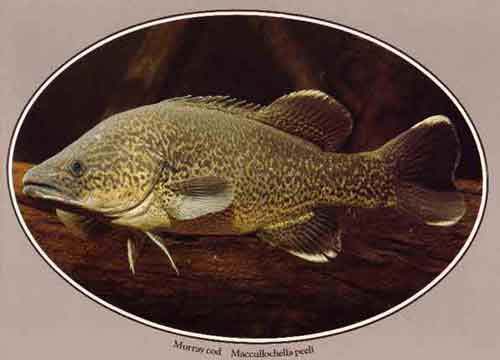
Murray Cod facing Extinction?
Goulburn-Murray Water is a large irrigation enterprise covering approximately 546,000 hectares, based north of the Great Divide in the south east Australian state of Victoria.
There are six Irrigation Areas within this region with 12,500 customers using an average of 2.1 million megalitres (ML) of water each year.
Aquatic weeds including indigenous species can invade these areas, which include approximately;
*6,756 km of earthen supply channels
*2,931 km of earthern drains
*394 km of domestic and stock channels
*17 major storages
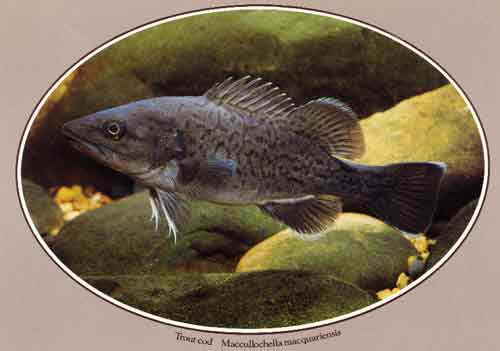
Trout Cod Facing Extinction?
Herbicides are used by GMW to maintain a relatively weed free drainage system.
Aquatic Plant Services (APS) are the small unit which oversees and develops all aspects of G-MW aquatic weed control. They are apparent leaders in the field of using the herbicide Acrolein.
Aquatic weeds can be described in the following ways;
*those that germinate below the water surface
*those that are normally rooted to the bed of the water body
*those that do not have the majority of foliage floating or submerged.
Channels and drains under the control of GMW are of earthern construction, are located in region with mild winters and summers which can get hotter than 40 degrees celcius. Weeds species such as Typha spp (Cumbungi) , Myriophyllum spp, Sagittaria spp (Arrowhead), Juncus spp (rushes), and a range of Gramineae spp (grasses) can grow very well in nutrient enriched drainage water. Common weeds include: Phragmites spp (Common Reed), Cumbungi, Arrowhead and Rushes.
Submersed weeds have a life cycle under water. These weeds cannot be controlled by foliar applied herbicides. Submersed weeds include Elodea Canadensis (Elodea), Potamogeton ochreatus (Blunt Pondweed), Potamogeton crispis (Curly Pondweed), Vallisneria spiralis (Ribbonweed). The worst of these weeds for GMW is Elodea which can also cause local flooding in drains.
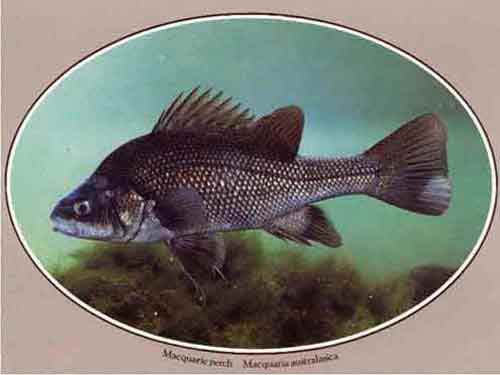
Macquarie Perch Facing Extinction?
There are only a few herbicides registered for weed control in supply channels, drains or reservoirs. Submersed weeds are mainly controlled by Acrolein.
GMW use Glyphosate (Roundup Active) to control Typha spp and Phragmites spp in irrigation channels and drains. It is also used to control Water Couch Paspalum distichum in drains. Normally applied at rates of between 6 and 9 L/ha for harder to control perennial weeds and between 1 and 3 L/ha for annual grasses. Residue limit is 0.1ppm. In natural waterways into which sprayed drains discharge, the limit is 0.01ppm.
GMW use Amitrole T or Amitrole TL Plus for the control of Paspalum distichum (Water couch) and Cyperus eragrostis (Umbrella Sedge) in drains. It can also be used to control Typha spp in drains. It is applied at rates of 20L/ha and often as a 10/10 split treatment. Amitrole is not usually used in supply channels as the acceptable residue limit in irrigation water is 0.002 ppm which only allows the use or 0.04 litres of product/ML flow.
2,4-D Amine is used by Goulburn Murray Water usually under the trade name Amicide LO500A. Used mainly for control of Sagittaria gramineae (Arrowhead) in supply channels and drains. Also can be used to control Myriophyllum spp and Juncus spp. Amicide LO500A is used at a rate of 10L/ha with an acceptable residue limit for irrigation water of 0.1ppm.
Acrolein is used by Goulburn Murray Water and is marketed as Magnacide H. It is used to control submersed weeds in supply channels and drains. Acrolein is injected at a point into a flowing stream. It evaporates quickly leaving few residues? Acrolein acts as a chemical mower, stripping submersed foliage from the bed of the channel or drain to allow unimpeded flow of water. Is used at rates of 15.0 ppm down to as low as 0.1 ppm with most treatments being around 0.3-0.5 ppm. Acrolein is manufactured by US oil industry company Baker Petrolite (a subsidiary of Baker Hughes) and is used to control bacterial populations and to eliminate hydrogen sulfide and iron sulfide in oilfield operations. It has been linked to fish mortality in the United States.
Herald - February 27 1971: MP Defends Killer of Weeds
"The Minister for Water Supply, Mr Dunstan, today defended the use of the weed killer Aqualin in irrigation channels...This month the Labor MLA for Kara Kara, Mr Curnow claimed that about 10,000 fish were killed when 24 gallons of Aqualin [were sprayed] into a 10 mile channel from Loddon Weir. Mr Dunstan agreed that Aqualin did kill some fish but it did not pollute the water...The weedicide is not used in rivers, but only in irrigation channels where any fish remaining in channels would die at the end of the season when the channels ran dry"
Rural Water Corporation Memorandum February 27 1985
"...On January 14th I was notified of another fish kill in the 2/2 Channel at Boort. This fish kill occurred in the same channel and in the same area as a fish kill I documented last year...It appears that this recent incident was associated with a tomato grower pumping wastewater back into the channel during or following aerial spraying..." Endosulfan?
Pesticide Review Committee Minutes March 22 1985
Rural Water Commission uses 22,000 litres of acrolein for some 250 acrolein treatments to control submersed weed growth over a supply channel/drain length of 2200km. Fish kill reported on the Goulburn River December 1984.
Rural Water Corporation Memorandum November 11 1986
"... In particular we have had a reported fish kill at Boort as a result of spraying of a tomato crop"
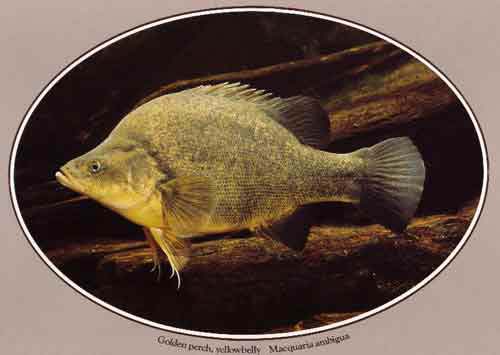
Golden Perch Facing Extinction?
GMW also use other herbicides that are not registed to be used on land near water for control of noxious weeds. GMW undertakes weed programs on channel and drain reserves in order to complement required works being carried out by landholders within Irrigation Areas. GMW through APS use handguns to spot spray for species such as Typha spp in supply channels. In regards to boom sprays GMW have a truck mounted, one sided boom system. The single sided boom is six metres in length with six spray nozzles set at one metre intervals. The nozzles are attached to droppers which deliver the herbicide close to the target area. GMW have nine such vehicles.
Acrolein is used via Acrolein Dispensing Units which are 2x2 metres boxed trailer containing Acrolein in an approved pressure vessel, pumping equipment and precision metering equipment. The unit can deliver 0-6 L/hr. Some treatments may take 60 hours to complete.
Glyphosate and 2,4-D have also reportedly been sprayed directly into creeks such as the Broken Creek and Nine Mile Creek by Goulburn Murray Water.
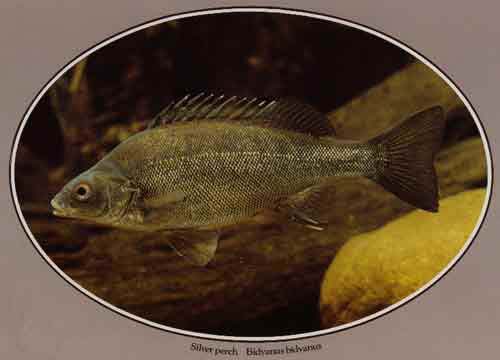
Silver Perch Facing Extinction?
Thwaites attacked on Tehan* job (Melbourne Age 18/8/04) by Richard Baker
*Marie Tehan was also the State's environment minister in the late 1990's. She was regarded very poorly amongst key environmental groups.
ALP members have attacked Environment Minister John Thwaites for appointing a former Kennett minister he once accused of being incompetent to the board of the state's biggest rural water authority.
The Reservoir ALP branch recently passed a motion condemning Mr Thwaites for appointing Marie Tehan, a former Liberal health and environment minister, to the board of the Goulburn-Murray Water Authority last month.
"The branch expresses deep disappointment that the former Liberal minister for health and the environment, who the state Labor Party said was unfit to hold public office, has now been appointed to this important post," the motion said.
"How can branches support a Government making such bad decisions? We condemn you and urge you to the rethink."
The Reservoir branch meets monthly in the electorate office of Labor's parliamentary secretary for justice, Jenny Mikalos. She is the upper house member for Jika Jika province.
Mrs Tehan will receive $31,500 a year during her three-year appointment. It is believed former federal Labor MP Peter Cleeland, who held the country seat of McEwen for several years, was overlooked for a board position in favour of Mrs Tehan.
Mr Thwaites was a fierce critic of Mrs Tehan when Labor was in opposition in the 1990s and called for her to resign as health minister because of problems with Victoria's ambulance dispatch system.
Accusing her of being involved in a cover-up, he told State Parliament in 1997 that Mrs Tehan "ought to resign if she had a shred of decency".
Saturday, November 13, 2004. 8:12am (AEDT) Gastro outbreak prompts Nagambie fishing warning
The Victorian Health Department is warning people not to eat fish caught in the Lake Nagambie area north of Melbourne. Six people have suffered a gastrointestinal illness after eating red fin caught in the lake or its tributaries in recent weeks. One person was treated in hospital but all have since recovered. Health Department spokesman Bram Alexander says the only factor common to all the patients was eating the fish. "They all had a bout of gastrointestinal illness but it wasn't your usual bout of gastro," he said. "One of the other symptoms or some of the other symptoms they had were dizziness, disorientation [and] numbness in the fingers and feet." The department says there is no problem with the area's drinking water and signs warning people not to eat the fish have been put up at 40 locations.
Goulburn Valley Water (Friends of the Earth Melbourne newsletter Summer 2007)
In 2006 FoE members may have been disturbed by an article in this newsletter which discussed issues surrounding weed control in irrigation channels in northern Victoria.
Some of these channels supply small rural communities with drinking water. Of particular concern were the herbicides Acrolein, Amitrole and 2,4-D. In December, Goulburn Murray Water, the water manager in the region, responded to a FoE Freedom of Information request. FoE was alarmed to find that in one channel in 2006, a reading for Amitrole was 1,000 times over the guideline limit for drinking water. A reading for 2,4-D was 30,000 times over the guideline limit for drinking water and a reading for glyphosate was 1,000 times over the guideline limit. Although the samples were taken from channels that most likely were not a source of drinking water, they give grounds for concern in regards to channels that are used for drinking water and sprayed with these herbicides. Amitrole for instance is an endocrine disruptor, has been linked to cancer, and has a half life in water of one month!
This concern was increased after a Freedom of Information request was sent back to FoE from Goulburn Valley Water, the regions drinking water provider.
Goulburn Valley Water does not even test for Acrolein or Amitrole! ... Some other small pollution events have occurred in the past decade, mainly with hexachlorobenzene and pentachlorophenol, although traces of 2,4-D were recently detected in Broken Creek. Broken Creek provides drinking water to the communities of Nathalia and Numurkah.
Other pesticides detected by Goulburn Murray Water included Endosulfan, Chlorpyrifos, Parathion Methyl and Atrazine in drains near orchards in the Ardmona, Shepparton and West Boort regions. These readings breached Australian and New Zealand Environment and Conservation Council (ANZECC) guidelines for aquaculture, potentially threatening populations of native fish in the region.
Chemical concerns raised The Weekly Times, January 2, 2008
by Leslie White
Environmental groups have called for a review of chemical spraying in irrigation drains and channels following a glyphosate reading 25 times the guideline level for protecting aquatic life.
The reading occurred after Goulburn Murray Water sprayed for aquatic weeds last year.
GMW was ordered to conduct testing after a large number of fish deaths in the Goulburn River in 2004.
Test results revealed a reading for glyphosate, the active ingredient in Round-Up, of 10.5 milligrams a litre.
The guideline level for protecting aquatic ecosystems is 0.37/mg a litre.
GMW planning and environment executive manager Alex Marshall admitted the reading was 'extremely high', but said that the sample had been taken immediately after spraying.
"This could have been shallow water," Mr Marshall said.
But Goulburn Valley Environment Group spokesman Nick Roberts and Environment Victoria chief executive Kelly O'Shanassy called for a review of chemical use in irrigation drains.
"There's a human consumption issue ... there's tens of thousands of people in Shepparton and towns along the Goulburn (taking drinking water from the river)," Mr Roberts said.
Ms O'Shannassy said failing to meet guidelines was "not good enough", adding healthy rivers were vital for rural communities.
The testing also found weed killer 2,4-D at 2.96mg a litre and amitrole at 1.06mg a litre.
It also found amitrole at 0.29mg a litre before GMW had begun spraying - likely caused by spray drift or runoff.
A two-year study by Department of Primary Industries and GMW consistently found three agricultural chemicals in Goulburn Murray waterways: the insecticide endosulfan, the powerful herbicide atrazine and the fungicide copper.
The three chemicals are associated with intensive orchards, vineyards, vegetables and pastures.
Endosulfan levels at Mooroopna, Ardmona, and Kyabram exceeded guidelines for aquaculture, while the report said it was "generally believed atrazine in irrigation water may be hazardous to some agricultural crops".
Ausveg chief executive John Roach said growers were "always concerned at the quality of input that goes into production".
"The vegetabale industry prides itself on quality, safe vegetable production - anything impacting on that is of concern."
GMW is the largest rural water supply authority in Australia.
Forestry in GMW catchments
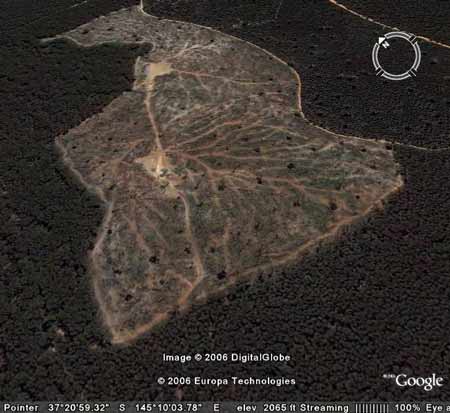
This image likely to be taken in 2005. Mt Disappointment State Forest. Probably Dabyminga Creek catchment which feeds into Sunday Creek.
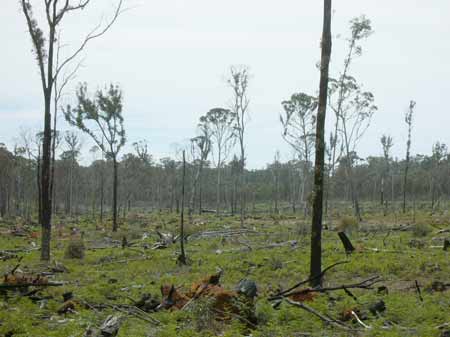
Same site in November 2006.
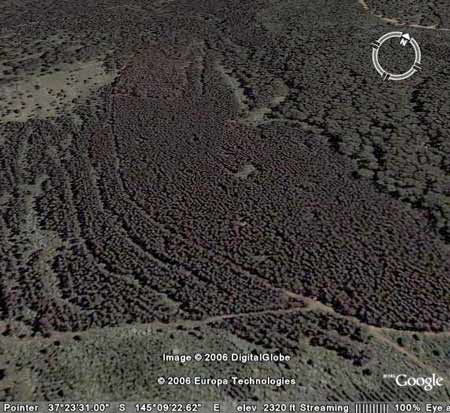
Plantation forestry inside Sunday Creek domestic water supply in Mount Disappointment State Forest. This catchment provides drinking water to Broadford, Kilmore and Kilmore East.
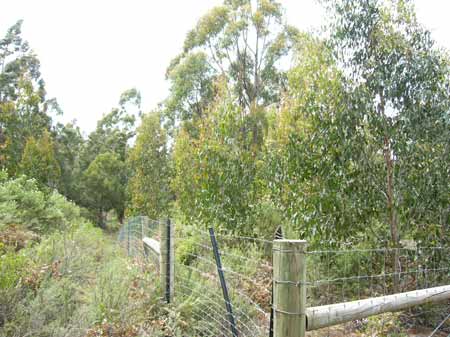
November 2006: Hardwood plantations off Morrisons Creek Road/Mount Disappointment State Forest. Sunday Creek Reservoir catchment.
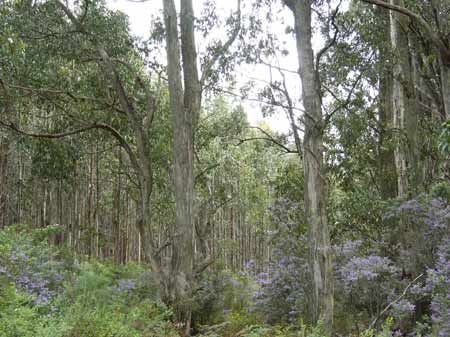
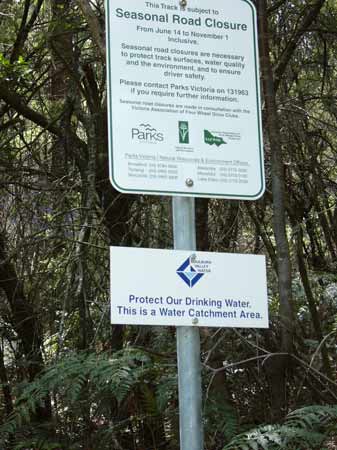
Sign off Plantation Road inside Sunday Creek reservoir catchment.
Water Management Issues

Sunday Creek Reservoir in drought - November 2006. Sunday Creek Reservoir supplies drinking water to the towns of Broadford, Kilmore and Kilmore East. Traces of Pentachlorophenol (PCP) at 2 µg/L (2 parts per billion) were detected in this reservoir in October 2005 by Goulburn Valley Water. The reading came in at 200 over the Australian Drinking Water Guideline (ADWG)Values and 80% under the ADWG health values.Pentachlorophenol is a chlorinated phenol and is a carcinogen, a suspected endocrine disruptor and has a high acute toxicity. The World Health Organisation class Pentachlorophenol as 1b (Highly Hazardous). PCP is known as being a wood preservative, a microbiocide, an algaecide, a fungicide and a mollusicide. So what is it doing being detected in this reservoir which has a largely closed catchment. See map.
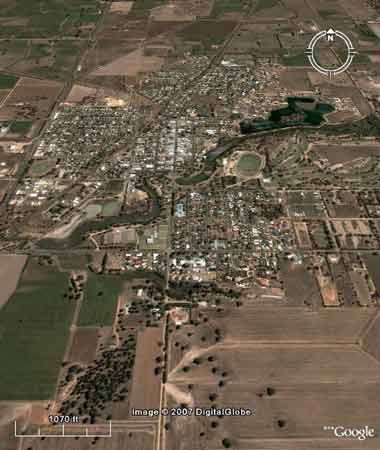
Broken Creek Numurkah: Pollution of the town's water supply, Broken Creek, occurred twice in 2005 detected at the offtake to the town. Pentachlorophenol (PCP) was detected at 1 µg/L in December and 2,4-D was detected at 17 µg/L in June. The 2,4-D reading was alarming.
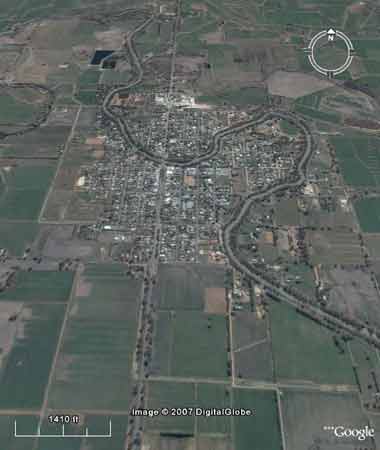
Broken Creek Nathalia, downstream from Numurkah.
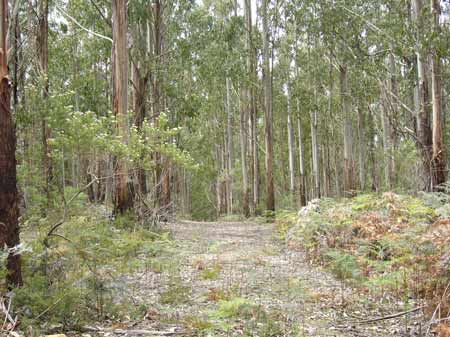
Regrowth forests at Mount Disappointment
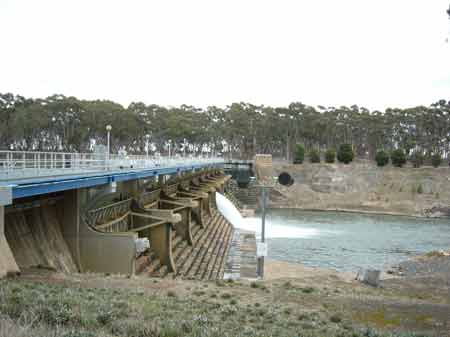
Goulburn Weir. Water is diverted near the weir into the East Goulburn Main Channel and also the Cattanach Canal (Waranga Basin).
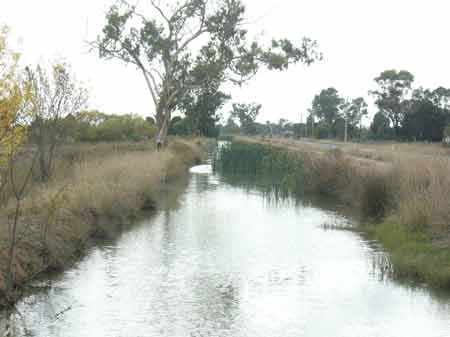
Tatura Water Supply. Channel No. 3/5. Low levels of the herbicides atrazine and endosulfan have been detected in this channel.

Boosey Creek and Katamatite Water Supply Offtake. It appears that drinking water is sourced from the Creek after flow is diverted from an irrigation channel north of the town.
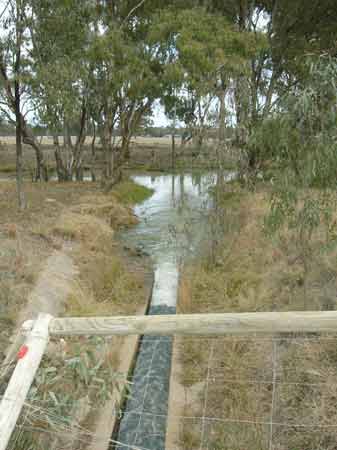
Diverted channel water flowing into Boosey Creek, Katamatite. The paddock in the background is sprayed with pesticides.

Channel from where Katamatite sources its drinking water. Low levels of Endosulphan and Atrazine have been detected in this channel.
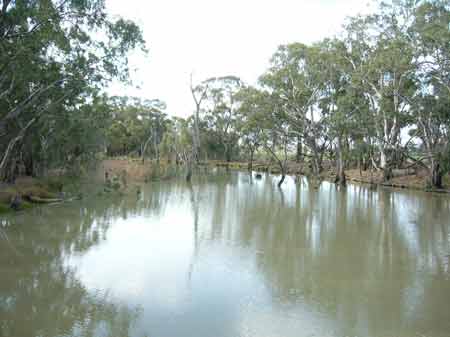
Broken Creek, 4km upstream from Nathalia. Broken Creek provides drinking water to Nathalia and Numurkah and is surrounded by agricultural cropping. Broken Creek is also sprayed with Glyphosate to kill aquatic weeds.
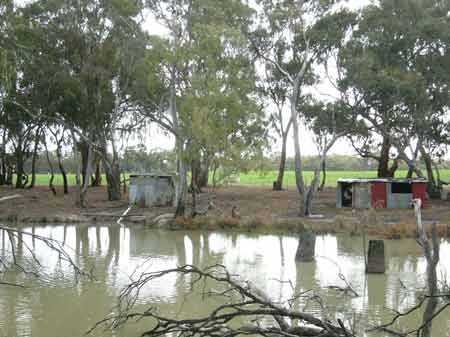
Irrigated pasture near Broken Creek, upstream of Nathalia's drinking water offtake.
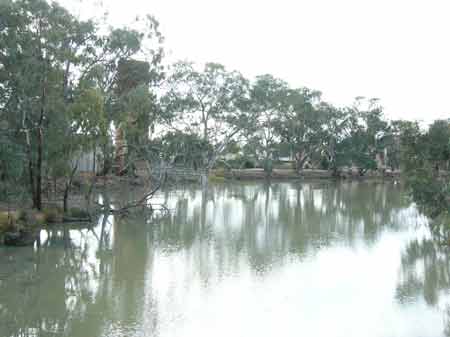
Broken Creek at Numurkah.
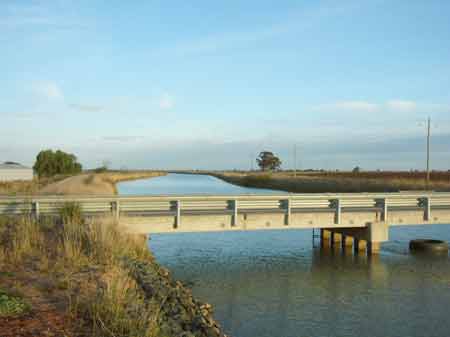
Waranga Western Channel, water supply for Rochester.

Irrigation channel flowing from Waranga Western Channel upstream from Rochester. Endosulphan and Atrazine have been detected in this channel.
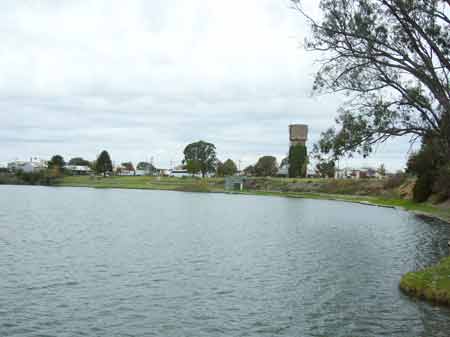
Lake Nagambie showing where drinking water is pumped from. Glyphosate used to control aquatic weeds at Lake Nagambie
Southern Rural Water also using Acrolein
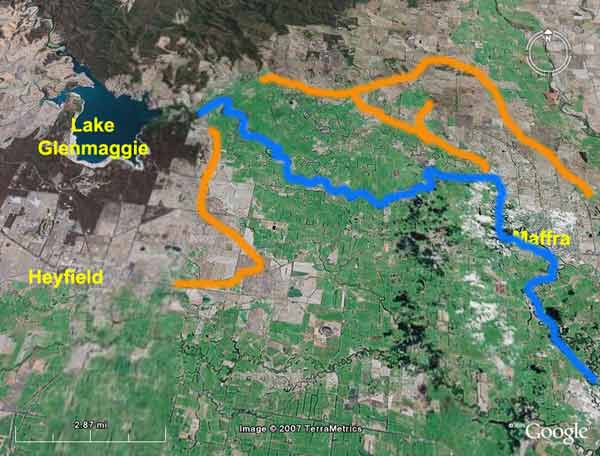
Rough image of Macalister River upstream of Maffra water supply offtake in central Gippsland (Stratford is also supplied from the Macalister). The blue indicates the approximate location of the Macalister River, the orange indicates approximate location of channels sprayed with Acrolein in January and November 2005. It is quite likely that residues of Acrolein may have entered the Macalister. Glyphosate is also used to control weeds in irrigation channels. According to the Gippsland Times 13/4/07 Maffra's water supply remains untested for chemicals such as herbicides and pesticides. Acrolein is also in the Thompson River catchment.
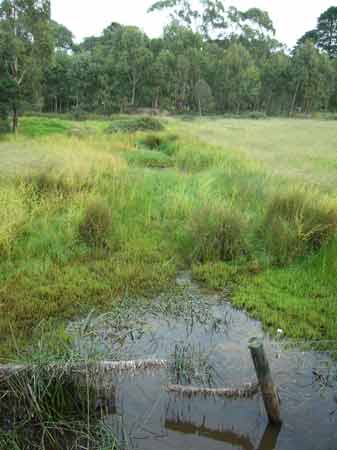
Kentucky Creek Gippsland flushed with Acrolein in 2005 by GMW contractors for Southern Rural Water
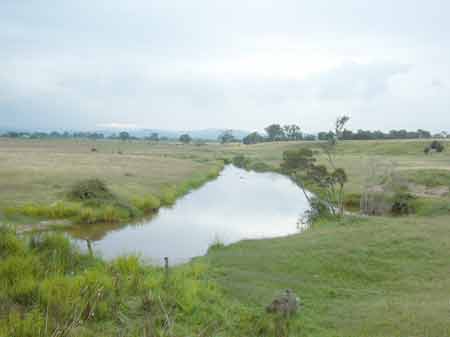
Kentucky Creek Gippsland flushed with Acrolein in 2005 by GMW contractors for Southern Rural Water
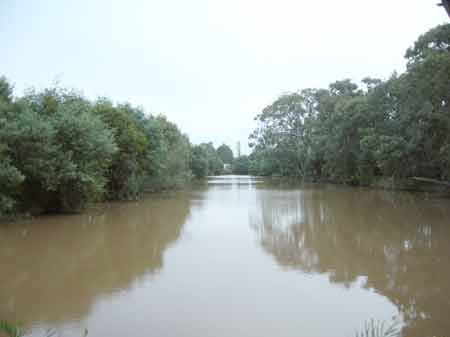
Macalister River Gippsland, near Maffra Offtake, possibly also was impacted by Acrolein in 2005 by GMW contractors for Southern Rural Water
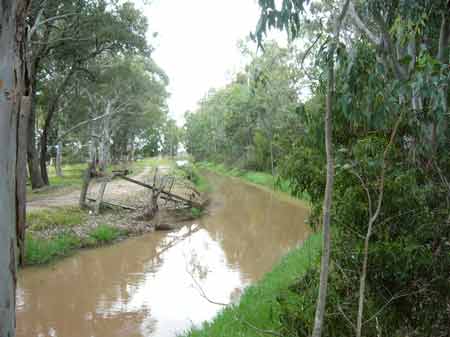
Main Sale Channel Gippsland flushed with Acrolein in 2005 by GMW contractors for Southern Rural Water
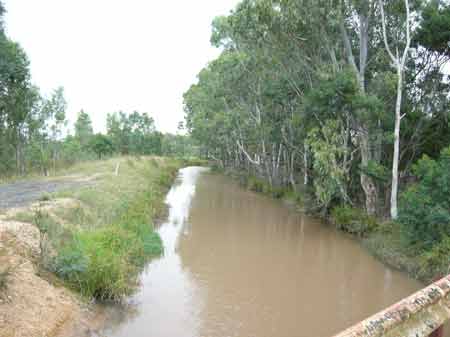
Northern Channel Gippsland flushed with Acrolein in 2005 by GMW contractors for Southern Rural Water
Sunday Age Page 1 Jason Dowling 17/6/07
The controversial proposal for a massive water pipeline from the Goulburn Valley to Melbourne that could pump an extra 150 billion litres of water into the city each year, looks set to move a step closer.
It is expected Premier Steve Bracks will announce the next stage of the plan as early as this week, breaking a long-standing taboo and a pre-election promise not to pipe water across the Great Dividing Range to boost the city's supply.
Water Minister John Thwaites is expected to outline his vision for the Goulburn Valley pipeline when he meets the Victorian Farmers' Federation tomorrow.
President Simon Ramsay said his organistion did not support the north-south pipe, but was willing to listen to the Government's proposal, providing there was a commitment to extensive consultation before any decision.
As Melbourne's water storages continue to fall despite rain, the Government is likely to elevate the Goulburn Valley pipeline, one of four major water supply proposals for Melbourne, to the feasibility or business-case planning stage. This increases its likelihood of proceeding.
Of the three other proposals, taking stormwater from the Yarra River and building a desalinisation plant are at the feasibility stage, and a plan to pipe recycled water to the LaTrobe Valley in return for drinking water is at the advanced business-case stage.
Last month, Treasuer John Brumby said an announcement about a new major water source or combination of supplies would be made "within months".
Federal Water Minsiter Malcolm Turnbull said the Commonwealth would not be providing money for the Goulburn pipeline proposal as an enticement for Victoria to sign up to its $10 billion Murray-Darling water plan.
Two Prong Plan for Water Herald Sun
Ellen Whinnett and Sarah Wotherspoon June 18, 2007 12:00am
THE Bracks Government will take a twofold approach to tackling Melbourne's water crisis: it looks set to pipe water across the Great Dividing Range and build a desalination plant.
With Melbourne's dams now at an alarming 28.4 per cent capacity, the Government is locked in a round of last-minute talks, desperately trying to secure support for its plans to allow an announcement to go ahead this week.
Water Minister John Thwaites' $2.4 billion push to have recycled water replace the billions of litres used to cool Latrobe Valley power stations appears to have been defeated.
Treasurer John Brumby has won the battle to have the $2 billion north-south pipeline from the Goulburn River deemed the top priority.
The rapid change of direction comes just two months after Mr Thwaites refused to commit to a government analysis of the north-south proposal.
In a meeting on Thursday Mr Brumby warned the four mayors of Campaspe, Moira, Swan Hill and Gunnawarra councils that if they did not support the north-south plan there would be no money for infrastructure upgrades in the Goulburn Murray irrigation district, said Moira Shire Mayor Frank Malcolm.
"At the end of the meeting, though, he gave us an assurance that if there was not widespread community support up here for the project then it would not go ahead," he said.
"I can tell you now there is no support for sending our water to Melbourne. "If you thought the fight over the Nowingi toxic waste dump was bad, just wait for the fight if this project gets the go ahead."
Investigations on a desalination plant are also continuing, with Premier Steve Bracks acutely aware there is unlikely to be enough time for any of four plans under consideration to be finished before the 2010 election.
Mr Thwaites will meet Victorian Farmers Federation president Simon Ramsay today and Mr Brumby will meet him tomorrow to seek support. Cabinet is to discuss the issue again today, and in the scramble to lock in a decision:
MR BRUMBY told a public meeting in Shepparton, attended by north-south proponent Ross McPherson, up to $750 million of state money could be available to upgrade channels in the area if the project went ahead.
MR RAMSAY said that the north-south plan might not deliver secure water supplies for at least eight years.
GREATER Shepparton Mayor Jenny Houlihan said the council would agree to the water being piped to Melbourne only after local economic and environmental water needs had been met.
NATIONAL Party water spokesman Peter Walsh said the north-south plan would not deliver the water surety Melburnians expected and a non-climate dependent solution was needed.
The north-south option, first proposed by irrigators, has been supported by Mr Brumby and party heavyweight Bill Shorten. Mr Thwaites supported the plan to recycle Melbourne's sewage water currently being flushed out to sea at the Gunnamatta outfall, and sending it to Gippsland to replace the drinking water used in the power stations.
That proposal has been unpopular with party strategists, who believe it contributed to the loss of two seats in the region at the November 25 election.
Mr Ramsay was adamant yesterday the VFF would not support the north-south plan until it saw the science. "The plan is very scant on details . . . it's a little bit vague in the financial areas," he said.
Mr Ramsay said the VFF had been kept in the dark about what the Government would announce about the north-south plan. "There's no water in the Goulburn at the moment anyway so I'm not quite sure what the rush is," he said.
Government spokesman Cameron Scott said yesterday that: "We are currently examining a range of water augmentation options for the state and we will make an announcement on the way forward by the end of this year."
Goulburn Catchment landuse above offtake to Sugarloaf Reservoir

King Parrot Creek
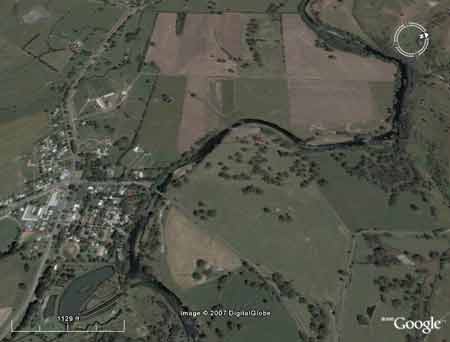
Goulburn River near Thornton

Goulburn River near Thornton
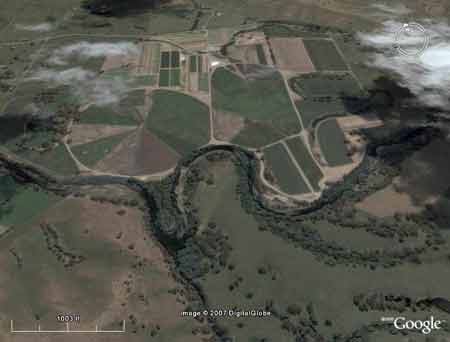
Goulburn River near Thornton
Residue testing in response to Goulburn River Audit 2005. Date 1/10/06 (in parts per billion)
| Site | Use | Herbicides | Date | Glyphosate | AMPA | 2,4-D Amine | Amitrole |
| Rodney Main Drain, Weller Rd, Wyuna | Irrigation Water | Amitrole & Glyphosate | 28/3/06 | <LOD | <LOD | NT | <LOD |
| Rodney Main Drain, Weller Rd, Wyuna | Irrigation Water | Amitrole & Glyphosate | 30/3/06 | <LOD | <LOD | NT | 2 |
| Rodney Main Drain, Weller Rd, Wyuna | Irrigation Water | Amitrole & Glyphosate | 1/4/06 | <LOD | <LOD | NT | 1 |
| Rodney Main Drain, Weller Rd, Wyuna | Irrigation Water | Amitrole & Glyphosate | 3/4/06 | <LOD | <LOD | NT | <LOD |
| Rodney Main Drain, Weller Rd, Wyuna | Irrigation Water | Amitrole & Glyphosate | 5/4/06 | <LOD | <LOD | NT | <LOD |
| Rodney Main Drain, Weller Rd, Wyuna | Irrigation Water | Amitrole & Glyphosate | 7/4/06 | <LOD | <LOD | NT | <LOD |
| Rodney Main Drain, Weller Rd, Wyuna | Irrigation Water | Amitrole & Glyphosate | 9/4/06 | <LOD | <LOD | NT | 3 |
| Rodney Main Drain, Weller Rd, Wyuna | Irrigation Water | Amitrole & Glyphosate | 11/4/06 | 80 | <LOQ | NT | 11 |
| Rodney Main Drain, Weller Rd, Wyuna | Irrigation Water | Amitrole & Glyphosate | 13/4/06 | <LOQ | <LOD | NT | 4 |
| Rodney Main Drain, Weller Rd, Wyuna | Irrigation Water | Amitrole & Glyphosate | 15/4/06 | <LOQ | <LOD | NT | 3 |
| Rodney Main Drain, Weller Rd, Wyuna | Irrigation Water | Amitrole & Glyphosate | 17/4/06 | <LOQ | <LOD | NT | 5 |
| Rodney Main Drain, Weller Rd, Wyuna | Irrigation Water | Amitrole & Glyphosate | 19/4/06 | <LOQ | <LOD | NT | 3 |
| Rodney Main Drain, Weller Rd, Wyuna | Irrigation Water | Amitrole & Glyphosate | 21/4/06 | <LOD | <LOD | NT | <LOD |
| Rodney Main Drain, Weller Rd, Wyuna | Irrigation Water | Amitrole & Glyphosate | 24/4/06 | <LOD | <LOD | NT | <LOD |
| Rodney Main Drain, Weller Rd, Wyuna | Irrigation Water | Amitrole & Glyphosate | 26/4/06 | <LOD | <LOD | NT | <LOD |
| Rodney Main Drain, Weller Rd, Wyuna | Irrigation Water | Amitrole & Glyphosate | 28/4/06 | <LOQ | <LOQ | NT | 2 |
| Rodney Main Drain, Weller Rd, Wyuna | Irrigation Water | Amitrole & Glyphosate | 30/4/06 | <LOQ | <LOD | NT | 29 |
| Rodney Main Drain, Weller Rd, Wyuna | Irrigation Water | Amitrole & Glyphosate | 2/5/06 | <LOQ | <LOD | NT | 1 |
| Rodney Main Drain, Weller Rd, Wyuna | Irrigation Water | Amitrole & Glyphosate | 3/5/06 | <LOD | <LOD | NT | <LOD |
| Rodney Main Drain, Weller Rd, Wyuna | Irrigation Water | Amitrole & Glyphosate | 6/5/06 | <LOD | <LOD | NT | 1 |
| Rodney Main Drain, Weller Rd, Wyuna | Irrigation Water | Amitrole & Glyphosate | 8/5/06 | <LOD | <LOD | NT | <LOD |
| Rodney Main Drain, Weller Rd, Wyuna | Irrigation Water | Amitrole & Glyphosate | 10/5/06 | <LOQ | <LOD | NT | <LOD |
| Rodney Main Drain, Weller Rd, Wyuna | Irrigation Water | Amitrole & Glyphosate | 12/5/06 | <LOD | <LOD | NT | <LOD |
| Rodney Main Drain, Weller Rd, Wyuna | Irrigation Water | Amitrole & Glyphosate | 13/5/06 | <LOD | <LOD | NT | <LOD |
| Community Surface Drain, Rodney Drainage System | Irrigation Water | Glyphosate | 10/4/06 | 10 | 10 | NT | 2 |
| Community Surface Drain, Rodney Drainage System | Irrigation Water | Glyphosate | 10/4/06 | 940 | 50 | NT | 1060 |
| Drain 8, Ardmona, Midland Highway | Irrigation Water | Glyphosate | 12/4/06 | <LOQ | <LOD | NT | NT |
| Drain 8, Ardmona, Midland Highway | Irrigation Water | Glyphosate | 12/4/06 | 10500 | 830 | NT | NT |
| Murray Valley CH13A/7/2 | Irrigation Water | 2,4-D | 9/5/06 | NT | NT | <LOD | NT |
| Murray Valley CH13A/7/2 | Irrigation Water | 2,4-D | 9/5/06 | NT | NT | <LOD | NT |
| Murray Valley CH13A/7/2 | Irrigation Water | 2,4-D | 10/5/06 | NT | NT | <LOD | NT |
| Murray Valley CH13A/7/2 | Irrigation Water | 2,4-D | 11/5/06 | NT | NT | <LOD | NT |
| Murray Valley CH13A/7/2 | Irrigation Water | 2,4-D | 12/5/06 | NT | NT | <LOD | NT |
| Murray Valley CH13A/7/2 | Irrigation Water | 2,4-D | 13/5/06 | NT | NT | <LOD | NT |
| Murray Valley CH13A/7/2 | Irrigation Water | 2,4-D | 14/5/06 | NT | NT | <LOD | NT |
| Murray Valley CH1/5 | Irrigation Water | 2,4-D | 9/5/06 | NT | NT | <LOD | NT |
| Murray Valley CH1/5 | Irrigation Water | 2,4-D | 9/5/06 | NT | NT | 2960 | NT |
| Murray Valley CH1/5 | Irrigation Water | 2,4-D | 10/5/06 | NT | NT | 1920 | NT |
| Murray Valley CH1/5 | Irrigation Water | 2,4-D | 11/5/06 | NT | NT | 1950 | NT |
| Murray Valley CH1/5 | Irrigation Water | 2,4-D | 12/5/06 | NT | NT | 2110 | NT |
| Murray Valley CH1/5 | Irrigation Water | 2,4-D | 13/5/06 | NT | NT | <LOD | NT |
| Murray Drain 6 | Irrigation Water | 2,4-D | 10/5/06 | NT | NT | <LOD | NT |
| Murray Drain 6 | Irrigation Water | 2,4-D | 10/5/06 | NT | NT | <LOD | NT |
| Murray Drain 6 | Irrigation Water | 2,4-D | 11/5/06 | NT | NT | <LOD | NT |
| Murray Drain 6 | Irrigation Water | 2,4-D | 12/5/06 | NT | NT | <LOQ | NT |
| Murray Drain 6 | Irrigation Water | 2,4-D | 13/5/06 | NT | NT | <LOD | NT |
| Irrigation Water | Amitrole & Glyphosate | 22/4/06 | <LOD | <LOD | NT | NT |
| Average | Glyphosate 461.2 ug/L | AMPA 30.689 ug/L | 2,4-D 525.882 ug/L | Amitrole 43.346 ug/L |
Australian Drinking Water Guidelines Health Value
Amitrole 10ppb. AMPA ?, Glyphosate 1000, 2,4-D 30
Australian Drinking Water Guidelines Value
Amitrole 1. AMPA ? Glyphosate 10. 2,4-D 0.1
LOD = Limit of Detection = 2ppb for Glyphosate and AMPA, 5ppb for 2,4-D and 0.5ppb for Amitrole.
LOQ - Limit of Quantitation = 10ppb for Glyphosate and AMPA, 10ppb for 2,4-D and 1ppb for Amitrole.
NT = Not Tested
